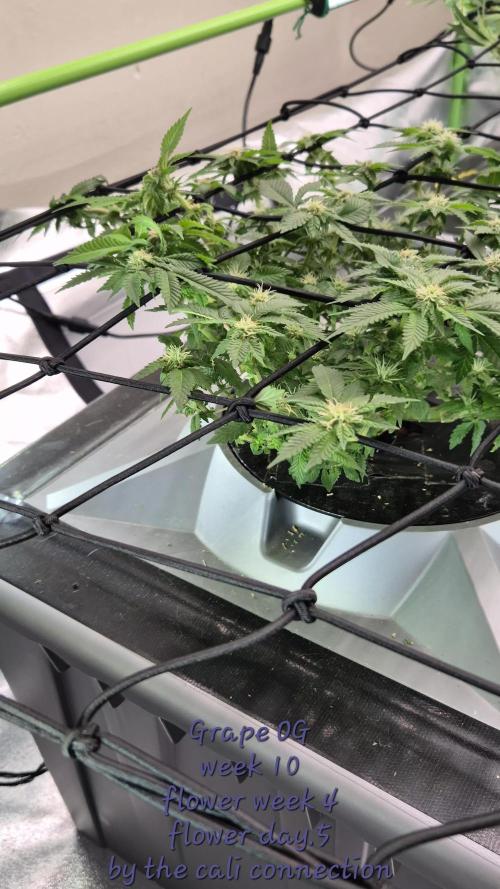The Grow Awards 2026 🏆 





























Likes
7
Share


@Danger90946
Follow
Here we are in week six of flower and not a lot has happen this week other than the usual watering and letting her do her thing. Only trouble this week was updating GoPro had to try a few times. Other than that we got some rain in my home town and collected about 60 gallons that I'm going to use to finish the rest of the grow. Also, got my new AC Infinity CLOUDLINE T4, Quiet Inline Duct Fan System with Temperature and Humidity Controller, 4-Inch. I was really hoping this two plants would finish before the year ended, however, it looks like they got others plans. See you guys next week.
Likes
21
Share


@Lontra
Follow
day 51:
I did some smaller repositioning and defoliation. It looks like she liked the more of nutrients i gave her yesterday. The buds are getting bigger, the pistils start to change their color and more trichomes are getting cloudy.
day 52:
Just visual check and filling up humidifier.
day 53:
Watering day. I increased the amount of Bio-Bloom, Top-Max and Bio-Heaven to 3ml/l. I'm now at about 6 liters of water every 3 days.
day 54:
Just visual check and filling up humidifier.
day 55:
Just visual check and filling up humidifier. The buds are getting bigger and more dense. From now I will have a close look at the pistils and the trichomes to decide when I will start to give her only plain (ph-regulated) water. I guess we have about 2-3 weeks to go from now. What are you thinking?
day 56:
Watering day. As most of the pistils are still white and most of the trichomes still clear, I gave her about 6 liters of water full of nutrients.
day 57:
While checking on her, I noticed some "burned" looking leaf tips. I guess that could've been a little too much nutrients last time. Overall she is looking happy.
Likes
33
Share


@BudXs
Follow
Thank you Heather, you rock as always. Stoked to get these soaked:)
Im impressed with FastBuds stability, terpene profiles and mass. These are great plants, happy and thankful to grow em out
Likes
24
Share


@Brothersfromweed420
Follow
Es una genética maravillosa sin duda la volveré a plantar otra vez es muy muy resistente tiene muy buen olor y unos tricoma de locos
Likes
12
Share


@Marihumama
Follow
The weather is shit 😵
She,still looking awesome😛 smelling lovely &Sweet 😍
Don't need to water her now, just shake the rain off every now &than ☺️
I love it when a plant comes together! 😎
Likes
17
Share


@Cultivandomedicinanatural
Follow
Bueno esta semana es la última de vida de nuestras pequeñas, un tamaño reducido y muchas juntas... pero una calidad.. dureza y resina... envidiables.. Esta semana usamos solamente agua con un ph de 6,2 y líquido solo usamos la final solution de b.a.c para limpiar nuestras raíces, al igual que aumentamos la cantidad de agua por riego para ir lavando bien nuestras raices. El olor es muy fuerte pero un aroma apetecible a más no poder... en cuanto abro el armario para los riegos y cuidados sale un olor... que si no fuera por el generador de ozono apestaría la casa!😍😋 En grandes rasgos una variedad de floración relativamente corta.. y con unos resultados impecables.. Hay una media de 5 puntas por planta y algunas incluso más!😍
Likes
8
Share


@GrowingABushWithButch
Follow
It's Day 54 Week 08 0f Flower For My 02 Kombucha Cream by atlasseed . And For My Snow White and SpliffStrawberry by Spliff Seeds Amsterdam . So Today I Started My Day By Checking My Tricomes On My 2 Kombucha Cream. The 02 Where Looking Fully Milky So My 02 Kombucha Cream Got Flushed TODAY with Some Flawless Finish by Advanced Nutrients . The 2 Received 80ml of Flawless Finish mix with 1OGallons Of Water Ph at 6.0. Tomorrow they will get Rinse off with ph balance water. Yesterday I watered my Snow White and SpliffStrawberry Ppm where down to 100ppm. All 4 Plants will get a nice ice bath in a few days. My plan is to check the Tricomes on the SpliffStrawberry In a few more days she was still Milky when I check her yesterday. I will chop her down next weekend. And the rest will get the chop at 30%Amber Tricomes.
Happy Growing Growmies 🤘🏻
Likes
7
Share


@IAmTheMoravianGrower
Follow
Hello growers ✌️ She looks nice but she needs more space. 😏 In the week, I'll probably move her somewhere. But I don't know where. 😏
Fertilization
16.6.2019
Fish Mix – 2ml/l
Root Juice – 3ml/l
Likes
9
Share


@RBG
Follow
Week 10
Flower week 4
Flower-day 1
05/11/2025
Nutrients change
Floramax veg1
Floramax Organabud
Floramax flowering enhancer
Floramax Rezin
Cyco platinum series silica
Green planet bud booster
Complete grow cal mag
( sensi unfortunately got refunded so got this instead today )
Sleeps with the fishez ( hocI )
Ladies are looking good overall, let the fun goodness begin i guess 😂
7/11/25
Blockage within systems finally fixed after 4 flushes. Not exactly sure what it was but whatever ive done has fixed it for now 🤷♂️😂 take it as a win for now i guess
11/11/25
Unfortunately I hate scrogg so took it off but once I had spread her out again with lst, I noticed that shes struggling with lower growth. I saw this with my autoflowers. I'm not too sure if its from too many budspots,colas or if it's just from being overpacked. So her pisitils showed up on the 25th, some people count from that date as flower and some count as soon as you flip, I've decided to go of the 25th as first pisitils so its only 3 n a half weeks currently.
I decided to take a few branches and a few of the lower budspots to try and help her even herself on where shes taking her sugars and growth.
No Defoilation, just 10 or so budspots n only 3 branches. I DONT NOT RECOMMEND doing any of this, I'm only reattempting this because it worked on autos I had going. I do think I've made the right choice
Grape og is meant to be a pretty hearty and forgiving strain, so she should bounce back pretty quickly
Oh well. I'll definitely be rerunning her again later in future but trying a different method
Likes
1
Share


@Gorillabraziu
Follow
Next week i will stop feeding her with grow nutrients, but decreasing (reduce) doses.
I am brazilian guy, so i dont write very well and not understand somethings 😅
Likes
111
Share


@DreamIT
Follow
🍋🥧🏎️ LEMON PIE AUTO BY FAST BUDS 🏎️🥧🍋
🍋 5.2 ...
🍋 6.2 ...
🍋 7.2 ...
🍋 8.2
🍋 9.2
🍋 10.2
🍋 11.2 today second top. , by the weekend I put in a 6.5 l pot, yeah
__________________________________________________________________________________________________
❌❓Not sure where to buy your seeds?
😮 Fast buds literally ships all over the world, check out their site!
http://bit.ly/FastBudsgood
__________________________________________________________________________________
📜 A look at the details of what I'm growing 📜
🍋🥧🏎️Lemon Pie Auto 🏎️🥧🍋
⚧ Gender
▪️ Feminised
➰ Genes
▪️ 50% Indica / 50% Sativa
🎄 Genetics
▪️ Lemon Pie X Autoflowering Genetics
🚜Harvest
▪️ 450 - 550 g / m²
🌱Vegetation
▪️30 - 35 days
🌷Flowering
▪️ 30-35 days
✨THC
▪️ 24.0%
✅CBD
▪️ 1.0%
🏡Room Type
▪️ Indoor
🌄Room Type
▪️ Outdoor
🕋Room Type
▪️ Greenhouse
🎂Release Year
▪️ 2020
__________________________________________________________________________
📷🥇 Follow the best photos on Instagram 🥇📷
https://www.instagram.com/dreamit420/
🔻🔻Leave a comment with your opinions if you pass by here🔻🔻
🤟🤗💚Thanks and Enjoy growth 💚🤗🤟
Likes
30
Share


@CanadianFillmore
Follow
Another week begins for the ladies, the weather has been decent, not to hot, not to humid. Not much else to report this week.
Thanks for stopping by growfessors 👽🌳💚
Likes
11
Share


@Sticky_Green_Fingers4
Follow
Hey folks coming to the end of week 7 and unfortunately what looks like to me is a bit of a P-K deficiency in one of the flowers, did up the ph gradually to 6.3 and it seems to be holding out as there is only maybe 14 or 15 days left on these baby's am not going to worry that much, so we will see how we get on this week and i'l update yea all again next week, 👍
Likes
25
Share


@Dabking
Follow
8.73 oz from 2 plants. Very dense and potent nugs. Love it so far. Now for curing
Likes
3
Share


@Virginia_Nugz_540
Follow
Okay so I’ve been slacking a bit on the grow-diaries, only because I’ve had a lot going on and also because I don’t feel obligated to do so because this isn’t a sponsored grow. It’s been nice to have a little break but I think I’m ready to come back at it full force again.
These girls are living their best lives, they are all the same age and they are all thriving. Floraflex nutrients, as well as some Silica, Regina-root, and a trichome enhancer called “Grease”!! Seems like the real deal. Watering every other day and let me tell you these girls are very thirsty. Defol as needed!
My new HLG Blackbird lamp fixture is out of this world. My 3 autos that you can also find in my profile absolutely blew up. I typically fit 4 autos in my 3x3 but now it’s essentially one Purple punch from Fastbuds and I had to cram 2 more inside basically because they are going crazy. Unfortunately I had to move them from under the blackbird and put them under a HLG350R and they are still going crazy. Basically what I’m saying is HLG Lamps=Crazy growth and amazing lamps!! HLG has a lifetime customer!
That’s it for now but check in next week to see the progress!
Thanks for tuning in. Until next time and as always, Stay Smokey my Friends!!! 💨💨💨
Instagram: Virginia_nugz_540
Sponsors:
Horticulture Lighting Group
HLG-Blackbird
HLG-600RSpec
HLG-350R Diablo (X2)
Discount code: Virginia_Nugz
Petra Tools
LTPRO 2.0 Backpack Sprayer
Trimbag
Standard Trimbag
Discount Code: Virginia_nugz
Fastbuds
Fastbuds Genetics
Goat and Monkey
Hydrokulture Store
4x4 Gorilla Tent























